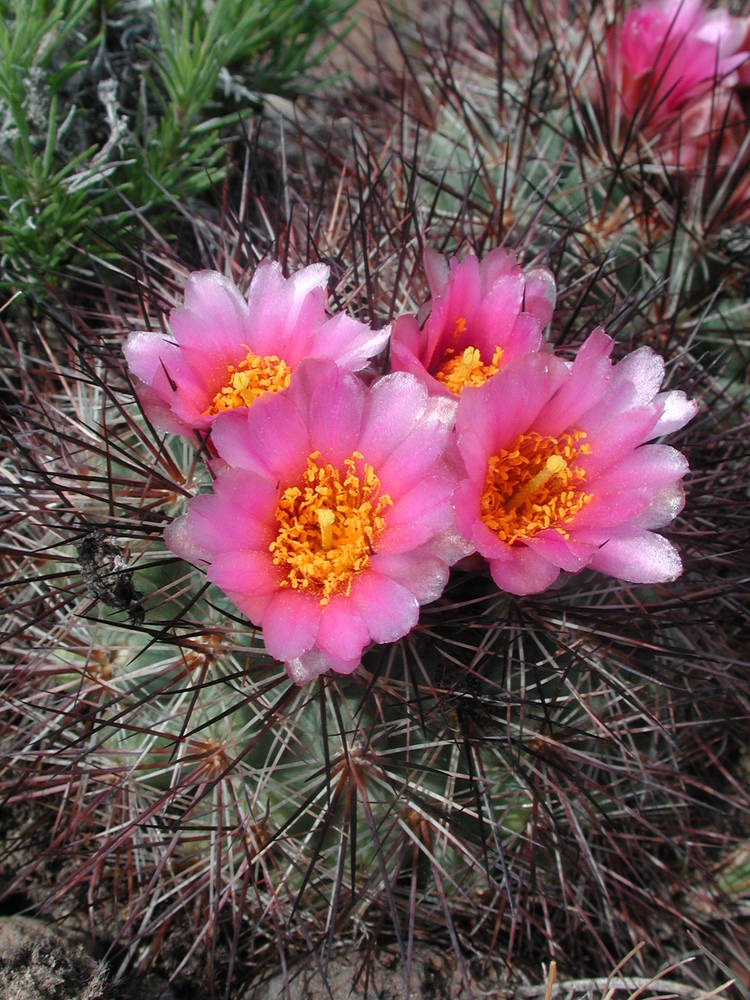
Plants often deeply seated in substrate.
Stems subglobose to depressed globose, 5–30 × 5–15 cm; tubercles in 8–13 spiral rows; radial spines 10–30 per areole, 8–20(25) mm, light yellow to reddish brown; central spines 8–12 per areole, 15–30(35) mm, reddish brown to black, lighter colored at base.
Flowers 1–3.5 × 2–5 cm, pale yellow to yellowish green, turning pink to purplish with age, clustered at or near top of stem; outer tepals with greenish brown stripe.
Fruits 5–10 mm.
Seeds 1.5–3 mm, gray to black.
2n=22.
Scrub and sagebrush. Flowering Apr–Jul. 500–2300 m. BR, BW, Lava. ID, WA. Native.
Older Oregon collections of this species were attributed to P. simpsonii. The two species are nearly identical and are separated only by overlapping spine characteristics (shape and length) and location. Combining the species and/or relegating P. nigrispinus to subspecific status may be in order.
as described under Pediocactus nigrispinus
Plants typically branched. Stems depressed-ovoid to elongate-ovoid, 5-30 × 5-15 cm; areoles oval, villous. Spines smooth, hard and rigid, distinguishable as radial and central; radial spines 10-30 per areole, spreading at right angles to tubercles, nearly straight, white to dull reddish brown, 8-20 mm; central spines 6-12 per areole, widely spreading or nearly erect, reddish brown to nearly black, rigid, straight or slightly curved, base yellow or cream, 15-35 mm, less than 1 mm diam. at base. Flowers 1-3.5 × 2.5-5 cm; scales and outer tepals of flower tube minutely toothed, laciniate, or entire and undulate; outer tepals with greenish brown midstripes, oblong-cuneate, 12-25 × 4.5-9 mm; inner tepals white, pink, magenta, yellow, or yellow-green, 19-27 × 5-10 mm. Fruits green tinged with red, drying reddish brown, short cylindric, 6-11 × 5-10 mm. Seeds gray to black, 2-3 × 1.5-2 mm, papillate but not rugose.Flowering spring. Great Basin desert scrub, sagebrush, grasslands, coniferous forests; 400-2000 m; Idaho, Oreg., Wash.No known morphologic character supports the taxonomic recognition of infraspecific taxa within Pediocactus nigrispinus. Characteristics used to distinguish the three described subspecies almost completely overlap. Pediocactus nigrispinus has been referred to P. simpsonii var. robustior (J. M. Coulter) L. D. Benson, which remains well within the range of variation for P. simpsonii. An unpublished study by J. M. Porter et al. of noncoding chloroplast DNA sequences shows P. simpsonii is less closely related to P. nigripsinus than to P. knowltonii, P. winkleri, and P. despainii.